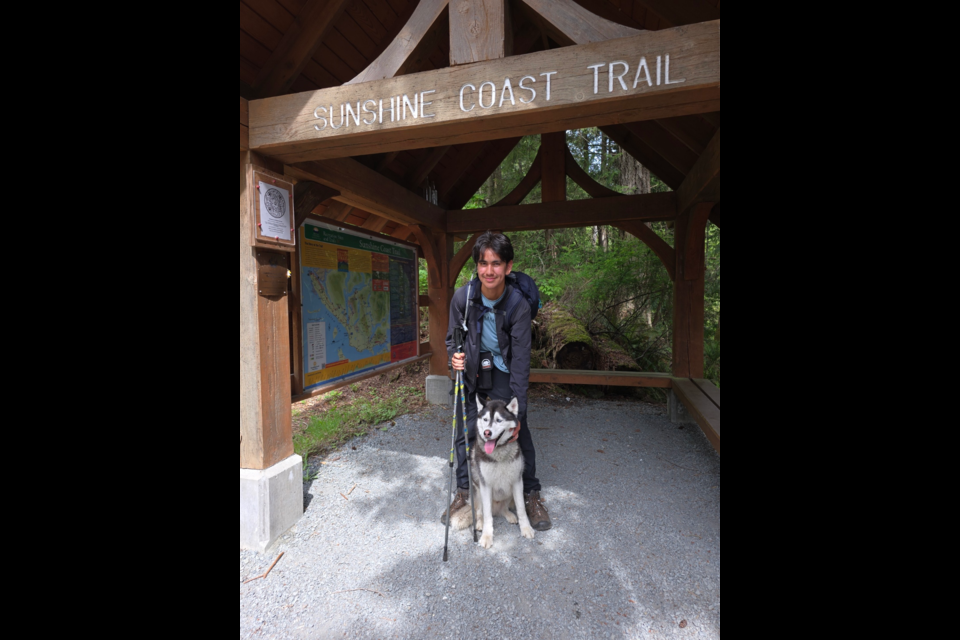When 17-year-old Hunter Gallegos asked his parents if they believed in him, meaning, did they believe he could safely hike the 180-kilometre Sunshine Coast Trail on his own, they said yes.
The main concern for his parents, Craig and Cathy Gallegos, along with his grandfather, Gerry, was communication.
"They wanted to make sure I had everything I needed, like a device called a Zoleo satellite communicator," said Hunter. "I also had bear spray and a bell, plus my Siberian husky came with me."
After stuffing his hiking pack with dehydrated food, clothing and a sleeping bag, Hunter's grandfather dropped him off at Sarah Point in mid-March, which was spring break for most high school students.
The Sunshine Coast Trail (SCT) is a backcountry hut-to-hut hike that has become a popular right of passage for many adventure seekers visiting or living on the northern Sunshine Coast. Although Hunter said he had little prior experience hiking overnight, he saw the trek as a good challenge for himself.
Stretching north to Sarah Point and south to Saltery Bay, the technical terrain of the trail takes hikers through diverse landscapes of alpine peaks, coastal beaches and old-growth forests. Wildlife is certainly a concern while on the remote trail and at that time, a wolfpack had been spotted in Tla'amin territory.
"I did see some wolf scat," said Hunter. "The first night was a bit demotivating as I looked towards Lang Bay and could see how far I had to go."
However, once Hunter got going, he said he decided to take it day by day, because he knew, eventually, he would arrive at Saltery Bay.
"I was ready to tackle the trail and spent my first night at Manzanita Hut," said Hunter. "I watched the sunset; it felt good."
The SCT trail is narrow with lots of root knots, so Hunter was glad he didn't leave his walking poles behind.
"I was motivated to get to Tin Hat hut because I knew it had a 360-degree view," said Hunter. "The trek up to Tin Hat was probably the toughest part of the hike."
He said he averaged 16 to 20 kilometres a day and for most of the hike he felt good mentally and physically. The weather was blustery, but luckily for him, there wasn't a lot of rain on his 10-day trek.
"The only night that I questioned whether I would be warm enough was at Elk Lake hut," said Hunter. "There is 800 metres of elevation and there was snow on the ground."
He said there were a lot of fallen trees, so he had to navigate whether to go over or under them.
"I was a little nervous around day five, as it was the farthest point from everywhere," said Hunter. "I didn't rush it because I didn't want to injure myself."
Hunter's mom joined her son at Elk Lake hut to show support. Then, at Mount Troubridge, both his mom, dad and younger brother came up and stayed the night.
Hunter hiked more than 130 kilometres and then took a break. He later went back onto the trail and completed the 50 or so kilometres he had left to officially complete the entire Sunshine Coast Trail.
As far as he knows, he is the first Tla'amin community member to complete the trail.
"The hike made me learn a lot about patience, and to take things day by day,” said Hunter. “I ate lunch at the very top of Tin Hat, which felt great. I tried to live in the moment."
After qathet Parks and Wilderness Society (qPAWS) cofounder Eagle Walz heard about Hunter's trek, he gifted his book, The Sunshine Coast Trail Guidebook, to him with a written message inside.
Hunter said he did use some Indigenous knowledge from his father and Tla'amin elders, such as carrying a piece of cedar for good luck and placing stones around his sleeping area for protection.
"The cedar has been very important to our culture," said Hunter. "I also thank qPAWS for their time [clearing the trail]."




